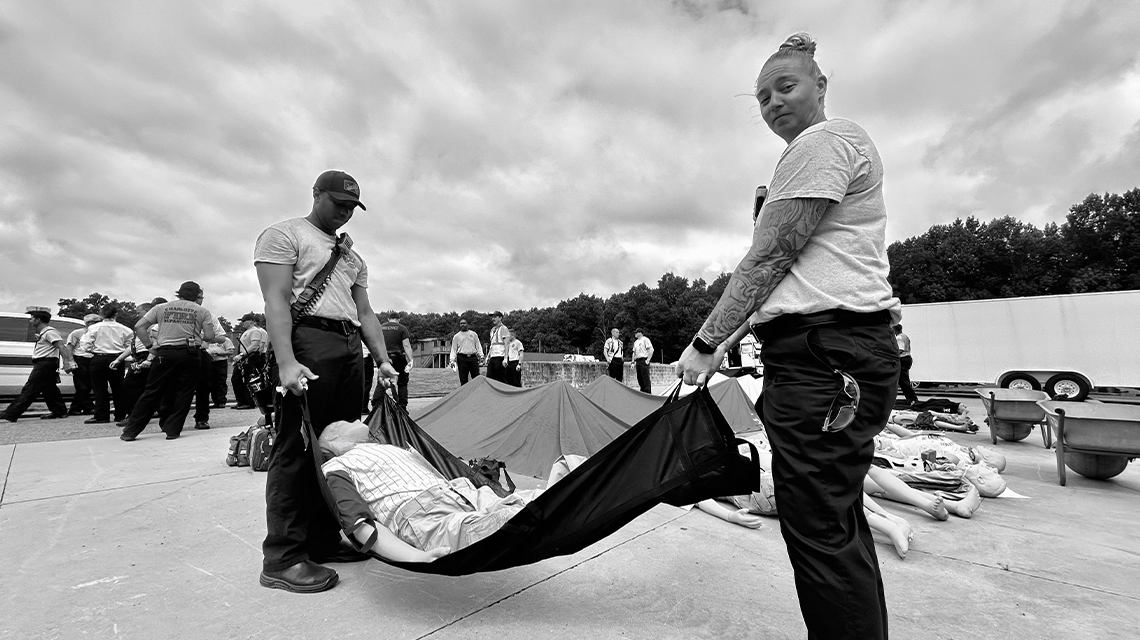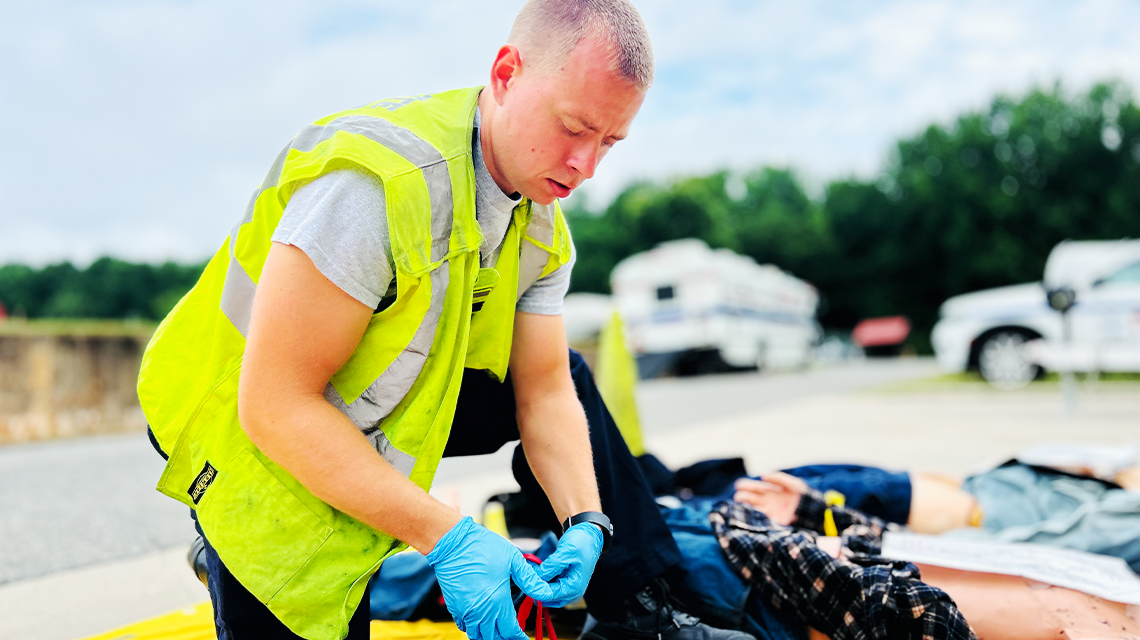Charlotte Fire Prepares for High-Stakes Mass Casualty Events
Published on July 04, 2025

Firefighters from Charlotte Fire assess and treat a simulated trauma victim during mass casualty incident training, working against the clock just as they would in a real emergency.
On a sweltering July morning at the Charlotte Fire Training Academy, sirens wailed and firefighters moved swiftly through a staged mass casualty scene. Scattered across the pavement were mannequins representing injured civilians—some tagged “immediate,” others “delayed” or “minor.” This wasn’t real, but it could be. And that’s the point.
Charlotte Fire’s Mass Casualty Incident (MCI) training—now in its third year—has evolved from classroom instruction to full-scale, high-intensity drills simulating the kind of tragedies seen around the world. From active shooter scenarios to vehicular assaults, firefighters are honing their skills in real time, driven by a singular purpose: saving lives when every second counts.

Surrounded by her crew, a Charlotte firefighter monitors simulated patients on the ground as part of the training’s triage phase, reinforcing teamwork and situational awareness.
The ongoing training series, directed by Battalion Chief Robert Fitzgerald of the Charlotte Fire Training Division, runs through August and reflects Charlotte Fire’s unwavering commitment to public safety and operational readiness.
“Mass casualties are something we hope never happen here, but we prepare as if they will,” Fitzgerald said. “It’s not a matter of if—it’s a matter of when.”
The scenario firefighters faced during this week’s drills was chillingly realistic—based on the January 2024 New Orleans vehicular assault where a driver plowed through a barricade, injuring and killing civilians before engaging in a shootout with police. For this simulation, a similar threat was imagined on a Charlotte roadway: multiple victims with varied injuries, an active shooter, and chaos.

Charlotte Fire personnel apply a tourniquet during a hands-on trauma care scenario, sharpening the life-saving skills they may need at a moment’s notice.
“The goal is to overwhelm their typical resources so they can practice under stress,” Fitzgerald explained. “This is about training our firefighters to think quickly, act efficiently, and prioritize care when the stakes are highest.”
Though firefighters are responding to lifeless dummies, each bears a card detailing simulated injuries and vital signs, allowing crews to practice using the “RPM” method of triage: Respirations, Perfusion, and Mental Status. These rapid assessments help categorize patients as red (immediate), yellow (delayed), green (minor), or black (deceased).

Battalion Chief Robert Fitzgerald, who leads the MCI training program, oversees operations and evaluates performance as crews rotate through high-pressure emergency simulations.
“In a mass casualty, you’re not doing full medical assessments,” Fitzgerald said. “You’re stopping life-threatening bleeding, making rapid triage decisions, and moving on.”
This year’s drills build on two years of progressive training. In the first year, individual firefighters practiced patient assessment in controlled indoor settings. The next year, the program advanced to full-company evolutions—crews responding as a unit to mock mass casualty events.
Now, the training has moved outdoors and expanded to replicate actual emergencies, complete with dynamic challenges, environmental obstacles, and the added complexity of coordinating patient movement across treatment zones.
“We’ve gradually increased the complexity,” said Fitzgerald. “This year, we added treatment area coordination and secondary triage, which simulates real-world patient flow during a crisis.”

A firefighter kneels beside a simulated victim, focused on rapid assessment and life-saving intervention—a critical part of Charlotte Fire’s commitment to readiness.
Though Charlotte firefighters are most often recognized for battling blazes, nearly 70% of their calls are medical in nature. Every sworn member of Charlotte Fire is a certified Emergency Medical Technician (EMT) through the state of North Carolina.
“People think we just fight fires,” Fitzgerald said. “But medical response is the largest part of what we do, and we have to be great at it.”
According to Fitzgerald, Charlotte Fire trucks are strategically stationed throughout the city to meet ISO response standards, enabling them to arrive at nearly any home in just over six minutes 90% of the time. That speed matters when seconds determine outcomes—whether it’s cardiac arrest, trauma, or a mass casualty event.
The frequency of mass casualty incidents across the U.S. is a sobering reality for public safety professionals. Events like the UNC campus shooting and international attacks in places like Nice, France, serve as grim reminders of the need for preparation.

Firefighters carry a victim in a rescue drag tarp, a tactic used when time and safety demand quick evacuation from hazardous areas in a mass casualty situation.
“The environment we live in now—sadly—makes this type of training essential,” Fitzgerald said. “We have to prepare for the day something unthinkable happens here.”
But it’s not just about mass tragedies. The same skills developed during MCI training improve performance in everyday emergencies.
“Whether it’s a car wreck with multiple victims or a fire with people trapped, this training makes our response sharper across the board,” Fitzgerald said.
Ahead of this month’s live drills, all participating firefighters were required to complete online training modules and review informational bulletins explaining the RPM triage method and MCI procedures. Fitzgerald says that layered learning approach—first digital, then classroom, then hands-on—has paid dividends.

A Charlotte Fire firefighter concentrates during a complex triage and treatment drill, part of a multi-phase training built to mirror the challenges of real-life emergencies.
“We’re seeing fast, accurate triage on the training ground,” he said. “They’re moving efficiently, and they’re learning how to coordinate movement to treatment areas.”
For the first time, crews are also setting up field treatment zones—critical in real-world MCIs. These zones allow for patients to be grouped by injury severity, reassessed, and prioritized for transport.
For Fitzgerald, who has spent decades preparing Charlotte’s firefighters, this training represents more than just technical skill. It’s about creating a culture of readiness.

Charlotte Fire personnel receive a walkthrough of a mass casualty transport bus, enhancing preparedness for high-demand medical responses.
“What I’ve seen is a lot of pride in how our firefighters are approaching this,” he said. “They take it seriously because they know this could be real one day.”
He adds that while fire academies teach the fundamentals of firefighting and medical response, specialized training like this ensures those fundamentals are continually refined and applied under pressure.
“Confidence is key,” he said. “We want every firefighter walking away from this knowing they can make the right call when the pressure is on.”

Wearing high-visibility vests, Charlotte Fire team members coordinate care zones during training, practicing clear communication and structured patient movement under pressure.
Charlotte Fire Chief Reginald Johnson praised the program’s growth and the dedication behind it.
“Charlotte Fire has become the all-purpose emergency resource for this city,” Johnson said. “When Charlotte is overwhelmed—whether it’s fire, medical, or a mass casualty—our community looks to its firefighters. This training shows we’re ready for anything.”
As the summer training sessions continue, hundreds of Charlotte Fire personnel will rotate through the MCI program at the training academy. Each day brings a new group, a new chance to practice, and a renewed focus on what it means to serve.

Focused and deliberate, a firefighter executes rapid trauma care as part of Charlotte Fire’s large-scale training exercise aimed at preparing for the unthinkable.
This training—quietly unfolding behind the walls of the academy—is a powerful testament to Charlotte Fire’s commitment to protecting its community not just today, but in every possible tomorrow.